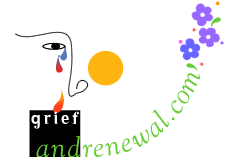|
||
 |
|
Connecting to Grief: Men's Paths to Healing My father died in November of 1994. During the week of his funeral my brother and I decided to design and construct the container for my father's ashes. That week my brother, Joel, and I spent time in my parent's garage, which had doubled as my father's workshop, planning and constructing his memorial container. During this time the men who came to visit our family tended to be drawn to the workshop, while the women who visited were more likely to spend time talking inside. The men who visited usually had ideas or comments about the work that was being done, and they gladly chipped in, and did this or that to aid in the project. These gender boundaries were not solid, though. We men spent plenty of time in the house talking with visitors about my father and what he meant to us, and the women would sometimes boldly venture into the workshop area. It was not that the men and women were separated, it was that the men and women tended to have different paths to connect them with their grief. Just as the tears flowed inside the house, they flowed in the workshop. As we worked we would share stories about my father. One of the most important parts of this experience was the presence of my father's 80 year old best friend, Charlie Beamen. Charlie, a retired minister, was also my father's woodworking buddy. As the three of us worked together we exchanged numerous stories. Joel and I told Charlie of our days with Dad growing up, and Charlie told us of his exploits with my father in the recent past. As we worked and told stories the tears and laughter flowed. We men had found a safe place to act as a "container" for our emotions. The workshop functioned in this manner to connect our pain and tears with an activity. The activity of building the memorial container became a "hook" for our pain. It seemed easier, as a man, to connect with my grief through an activity rather than by simply "sharing" it. The women, I noticed, appeared to have great skill in simply sharing their grief. They were more drawn to connecting their pain, tears, and grief on a verbal level with their most intimate friends and family. In doing further research into the bereavement process I learned that my experience reflected the differences men and women have in the grief process. This difference puts men in a precarious state in our culture because almost all of the "action" activities related to death have been sub-contracted. Activities such as building the coffin, directing the ritual, digging the grave, or the funeral itself have been turned over to the "death professionals." This leaves men with nothing to do following a death and thereby negates many men's strength of action. Evidence supporting these observations can be found in looking at tribal cultures and the ways they separate the tasks and roles of men and women following a death. For example, the Bara people in Madagascar literally separate the men and women. Two huts are designated: the "male hut" for the men and the "house of tears" for the women. The house of tears is the center of emotional expression, while the male hut is more the center of activities such as directing the ritual. In Australia the men of the Yolngu sing sacred songs around the bed of the person who is ill, and if death occurs, the songs continue as a means of orienting the newly dead to the Ancestors. It is said that the women join in the song with their crying and keening and the blend creates a sound of great beauty. The Dagura men of Africa dance out their grief for the person who died. In a different African tribe the men will approach the women who are actively crying and keening and stand silently next to them. The men do this to use the women's grief as a hook, that is as a way to ignite and resonate their own pain. This action is similar to that of a tuning fork. If one tuning fork is struck close to another one that is still, the still tuning fork will begin to resonate with the same vibration of it's active neighbor. By standing near the actively grieving women the men start to get in touch with their own pain. In other cultures the men sing the life of the person who died. There are many more examples of the separate, but complementary tasks of mourning assigned to men and women in different cultures. The point here is that the men are usually given active tasks following a death and these tasks become "hooks" to facilitate a connection to their pain. Once the pain is "hooked," it can be expressed and released which brings us one step closer to healing. In our own culture there are also examples of men who use a task or activity to connect to their emotional pain. Eric Clapton wrote a song about his child who died. Through his strength of music Clapton has found a way to honor his pain by creating a song about his son. Abraham Lincoln is said to have had a habit of inviting a male friend to the hite House to play what Lincoln called "sad songs." This man and Lincoln would walk silently to a room in the White House and the man would sit at the piano and play the songs. As he played Lincoln would sit and cry. The songs were Lincoln's hook to enter his state of grief. Other examples include the AIDS Quilt, all of the memorials in Washington D.C., and a memorial World Wide Web site, such as the one I created as part of my work in the area of grief. All of these examples provide people activities which allow a connection to their pain by actively honoring the person who died. This can be a powerful healing IF the activity is connected with the pain. If not connected to the pain, it is merely a hollow exercise. While men and women have different strengths and needs in their healing process, these needs are often complementary and overlapping. As our culture finds it difficult to recognize and hold the pain that comes with loss, members of both sexes often find themselves in a difficult place when it comes to grief. We need more culturally endorsed "active" rituals that give us "hooks" into our grief. By becoming aware of the differences we have in our own chosen style of grief and healing, we are in a better position to find our own hooks and honor those around us and ourselves.
return to top
|
